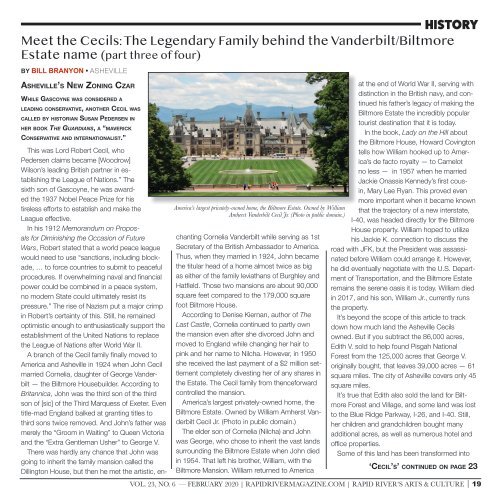February 2020 Issue
Works of art defining the contemporary age in WNC. Cover: ‘Downtown,’ 24x24, by Mark Bettis
Works of art defining the contemporary age in WNC.
Cover: ‘Downtown,’ 24x24, by Mark Bettis
You also want an ePaper? Increase the reach of your titles
YUMPU automatically turns print PDFs into web optimized ePapers that Google loves.
HISTORY<br />
Meet the Cecils: The Legendary Family behind the Vanderbilt/Biltmore<br />
Estate name (part three of four)<br />
BY BILL BRANYON • ASHEVILLE<br />
Asheville’s New Zoning Czar<br />
While Gascoyne was considered a<br />
leading conservative, another Cecil was<br />
called by historian Susan Pedersen in<br />
her book The Guardians, a “maverick<br />
Conservative and internationalist.”<br />
America’s largest privately-owned home, the Biltmore Estate. Owned by William<br />
Amherst Vanderbilt Cecil Jr. (Photo in public domain.)<br />
This was Lord Robert Cecil, who<br />
Pedersen claims became [Woodrow]<br />
Wilson’s leading British partner in establishing<br />
the League of Nations.” The<br />
sixth son of Gascoyne, he was awarded<br />
the 1937 Nobel Peace Prize for his<br />
tireless efforts to establish and make the<br />
League effective.<br />
In his 1912 Memorandum on Proposals<br />
for Diminishing the Occasion of Future<br />
Wars, Robert stated that a world peace league<br />
would need to use “sanctions, including blockade,<br />
… to force countries to submit to peaceful<br />
procedures. If overwhelming naval and financial<br />
power could be combined in a peace system,<br />
no modern State could ultimately resist its<br />
pressure.” The rise of Nazism put a major crimp<br />
in Robert’s certainty of this. Still, he remained<br />
optimistic enough to enthusiastically support the<br />
establishment of the United Nations to replace<br />
the League of Nations after World War II.<br />
A branch of the Cecil family finally moved to<br />
America and Asheville in 1924 when John Cecil<br />
married Cornelia, daughter of George Vanderbilt<br />
— the Biltmore Housebuilder. According to<br />
Britannica, John was the third son of the third<br />
son of [sic] of the Third Marquess of Exeter. Even<br />
title-mad England balked at granting titles to<br />
third sons twice removed. And John’s father was<br />
merely the “Groom in Waiting” to Queen Victoria<br />
and the “Extra Gentleman Usher” to George V.<br />
There was hardly any chance that John was<br />
going to inherit the family mansion called the<br />
Dillington House, but then he met the artistic, enchanting<br />
Cornelia Vanderbilt while serving as 1st<br />
Secretary of the British Ambassador to America.<br />
Thus, when they married in 1924, John became<br />
the titular head of a home almost twice as big<br />
as either of the family leviathans of Burghley and<br />
Hatfield. Those two mansions are about 90,000<br />
square feet compared to the 179,000 square<br />
foot Biltmore House.<br />
According to Denise Kiernan, author of The<br />
Last Castle, Cornelia continued to partly own<br />
the mansion even after she divorced John and<br />
moved to England while changing her hair to<br />
pink and her name to Nilcha. However, in 1950<br />
she received the last payment of a $2 million settlement<br />
completely divesting her of any shares in<br />
the Estate. The Cecil family from thenceforward<br />
controlled the mansion.<br />
America’s largest privately-owned home, the<br />
Biltmore Estate. Owned by William Amherst Vanderbilt<br />
Cecil Jr. (Photo in public domain.)<br />
The elder son of Cornelia (Nilcha) and John<br />
was George, who chose to inherit the vast lands<br />
surrounding the Biltmore Estate when John died<br />
in 1954. That left his brother, William, with the<br />
Biltmore Mansion. William returned to America<br />
at the end of World War II, serving with<br />
distinction in the British navy, and continued<br />
his father’s legacy of making the<br />
Biltmore Estate the incredibly popular<br />
tourist destination that it is today.<br />
In the book, Lady on the Hill about<br />
the Biltmore House, Howard Covington<br />
tells how William hooked up to America’s<br />
de facto royalty — to Camelot<br />
no less — in 1957 when he married<br />
Jackie Onassis Kennedy’s first cousin,<br />
Mary Lee Ryan. This proved even<br />
more important when it became known<br />
that the trajectory of a new interstate,<br />
I-40, was headed directly for the Biltmore<br />
House property. William hoped to utilize<br />
his Jackie K. connection to discuss the<br />
road with JFK, but the President was assassinated<br />
before William could arrange it. However,<br />
he did eventually negotiate with the U.S. Department<br />
of Transportation, and the Biltmore Estate<br />
remains the serene oasis it is today. William died<br />
in 2017, and his son, William Jr., currently runs<br />
the property.<br />
It’s beyond the scope of this article to track<br />
down how much land the Asheville Cecils<br />
owned. But if you subtract the 86,000 acres,<br />
Edith V. sold to help found Pisgah National<br />
Forest from the 125,000 acres that George V.<br />
originally bought, that leaves 39,000 acres — 61<br />
square miles. The city of Asheville covers only 45<br />
square miles.<br />
It’s true that Edith also sold the land for Biltmore<br />
Forest and Village, and some land was lost<br />
to the Blue Ridge Parkway, I-26, and I-40. Still,<br />
her children and grandchildren bought many<br />
additional acres, as well as numerous hotel and<br />
office properties.<br />
Some of this land has been transformed into<br />
‘Cecil’s’ continued on page 23<br />
VOL. 23, NO. 6 — FEBRUARY <strong>2020</strong> | RAPIDRIVERMAGAZINE.COM | RAPID RIVER’S ARTS & CULTURE | 19















